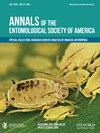The Enigmatic Culex pipiens (Diptera: Culicidae) Species Complex: Phylogenetic Challenges and Opportunities From a Notoriously Tricky Mosquito Group
IF 1.8
3区 农林科学
Q1 ENTOMOLOGY
引用次数: 10
Abstract
Abstract Our understanding of how natural selection and demographic processes produce and maintain biological diversity remains limited. However, developments in high-throughput genomic sequencing coupled with new analytical tools and phylogenetic methods now allow detailed analyses of evolutionary patterns in genes and genomes responding to specific demographic events, ecological changes, or other selection pressures. Here, we propose that the mosquitoes in the Culex pipiens complex, which include taxa of significant medical importance, provide an exceptional system for examining the mechanisms underlying speciation and taxonomic radiation. Furthermore, these insects may shed light on the influences that historical and contemporary admixture have on taxonomic integrity. Such studies will have specific importance for mitigating the disease and nuisance burdens caused by these mosquitoes. More broadly, they could inform predictions about future evolutionary trajectories in response to changing environments and patterns of evolution in other cosmopolitan and invasive species that have developed recent associations with humans.神秘的库蚊(双翅目:库蚊科)物种复群:来自臭名昭著的棘手蚊子群的系统发育挑战和机遇
我们对自然选择和人口过程如何产生和维持生物多样性的理解仍然有限。然而,高通量基因组测序的发展,加上新的分析工具和系统发育方法,现在可以详细分析基因和基因组的进化模式,以响应特定的人口统计学事件、生态变化或其他选择压力。在此,我们提出,包括具有重要医学意义的分类群在内的库蚊复合体为研究物种形成和分类辐射的机制提供了一个特殊的系统。此外,这些昆虫可能揭示了历史和现代混合对分类完整性的影响。这些研究对于减轻这些蚊子造成的疾病和滋扰负担具有特别重要的意义。更广泛地说,它们可以预测未来的进化轨迹,以应对不断变化的环境和其他世界性和入侵物种的进化模式,这些物种最近与人类发展了联系。
本文章由计算机程序翻译,如有差异,请以英文原文为准。
求助全文
约1分钟内获得全文
求助全文
来源期刊
CiteScore
4.90
自引率
0.00%
发文量
25
审稿时长
6-12 weeks
期刊介绍:
The Annals of the Entomological Society of America exists to stimulate interdisciplinary dialogue across the entomological disciplines and to advance cooperative interaction among diverse groups of entomologists. It seeks to attract and publish cutting-edge research, reviews, collections of articles on a common topic of broad interest, and discussion of topics with national or international importance. We especially welcome articles covering developing areas of research, controversial issues or debate, and topics of importance to society. Manuscripts that are primarily reports of new species, methodology, pest management, or the biology of single species generally will be referred to other journals of the ESA. The most important criteria for acceptance are quality of work and breadth of interest to the readership.

 求助内容:
求助内容: 应助结果提醒方式:
应助结果提醒方式:


